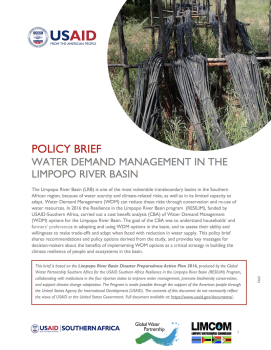The Limpopo River basin is one of the most vulnerable transboundary basins in the Southern African region, because of water scarcity and climate-related risks, as well as in its limited capacity to adapt. Water Demand Management (WDM) can reduce these risks through conservation and re-use of water resources.
In 2016 the Resilience in the Limpopo River Basin program (RESILIM), funded by USAID/Southern Africa, carried out a cost benefit analysis (CBA) of WDM options for the Limpopo River basin. The goal of the CBA was to understand households’ and farmers’ preferences in adopting and using WDM options in the basin, and to assess their ability and willingness to make trade-offs and adapt when faced with reduction in water supply. This policy brief shares recommendations and policy options derived from the study, and provides key messages for decisionmakers about the benefits of implementing WDM options as a critical strategy in building the climate resilience of people and ecosystems in the basin.
This brief is based on the Limpopo River Basin Disaster Preparedness Action Plan 2016, produced by the Global Water Partnership Southern Africa for the USAID Southern Africa RESILIM Program, collaborating with institutions in the four riparian states to improve water management, promote biodiversity conservation, and support climate change adaptation.


